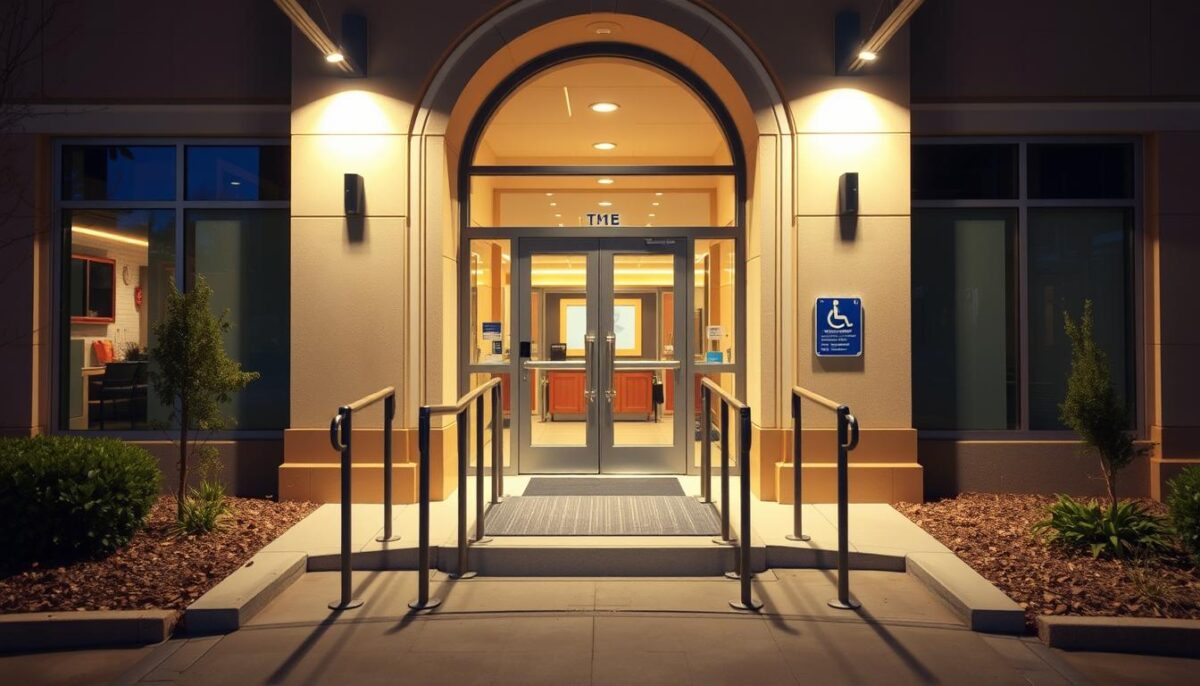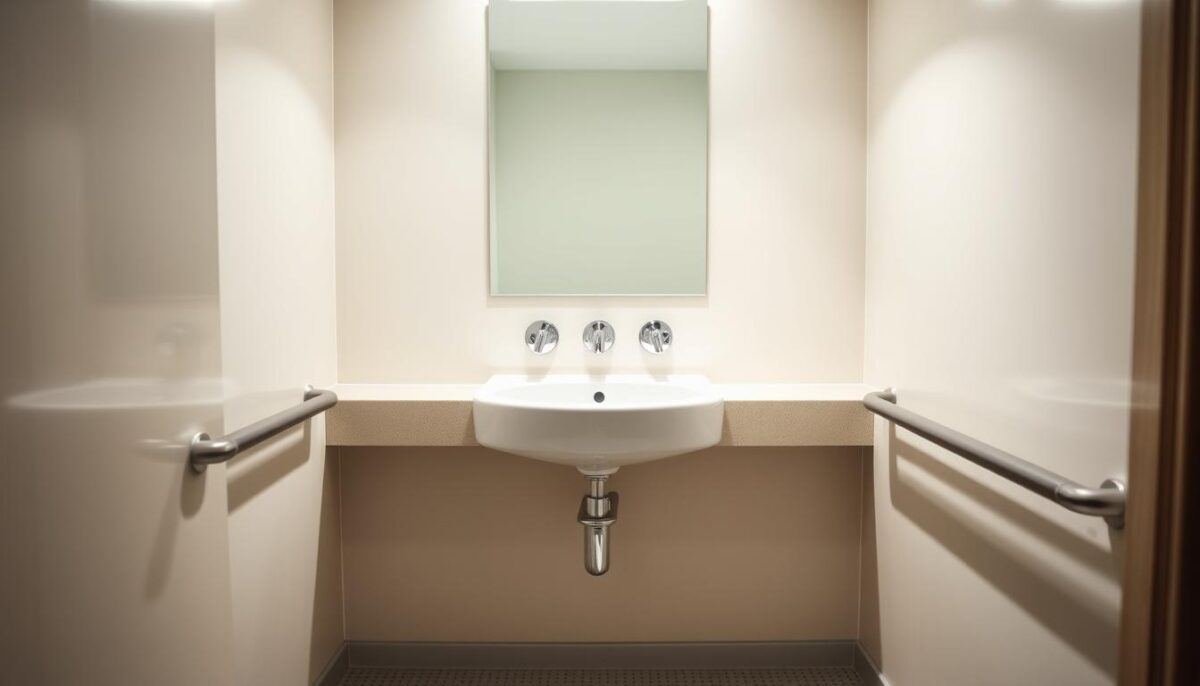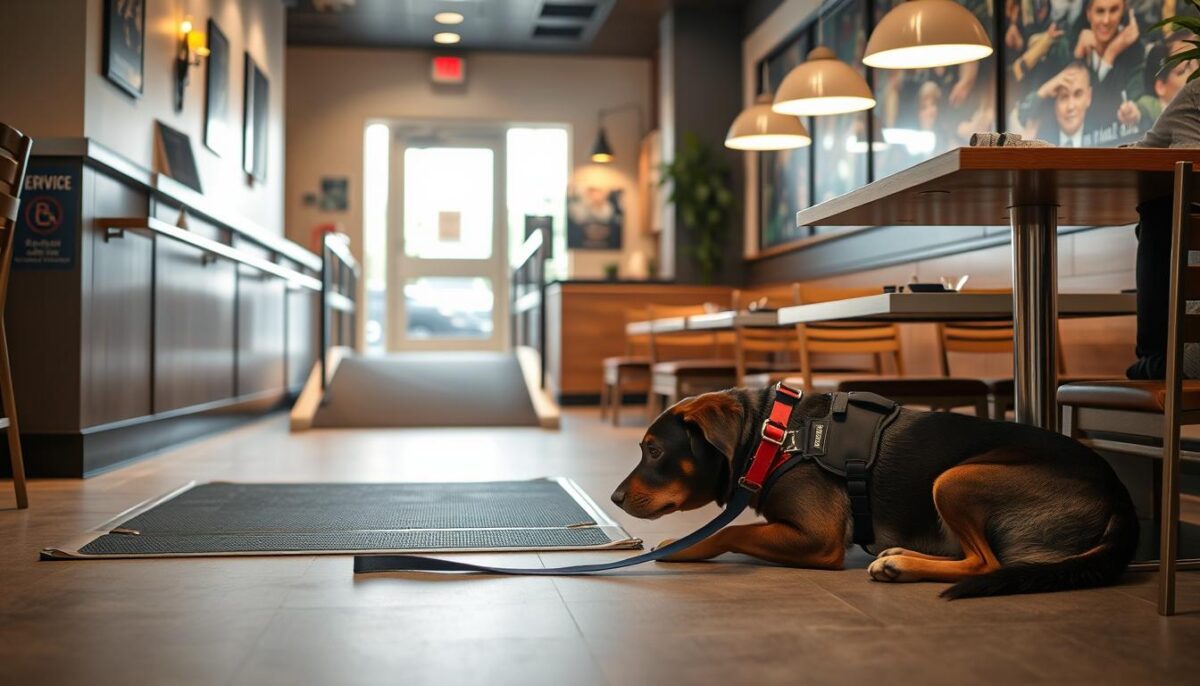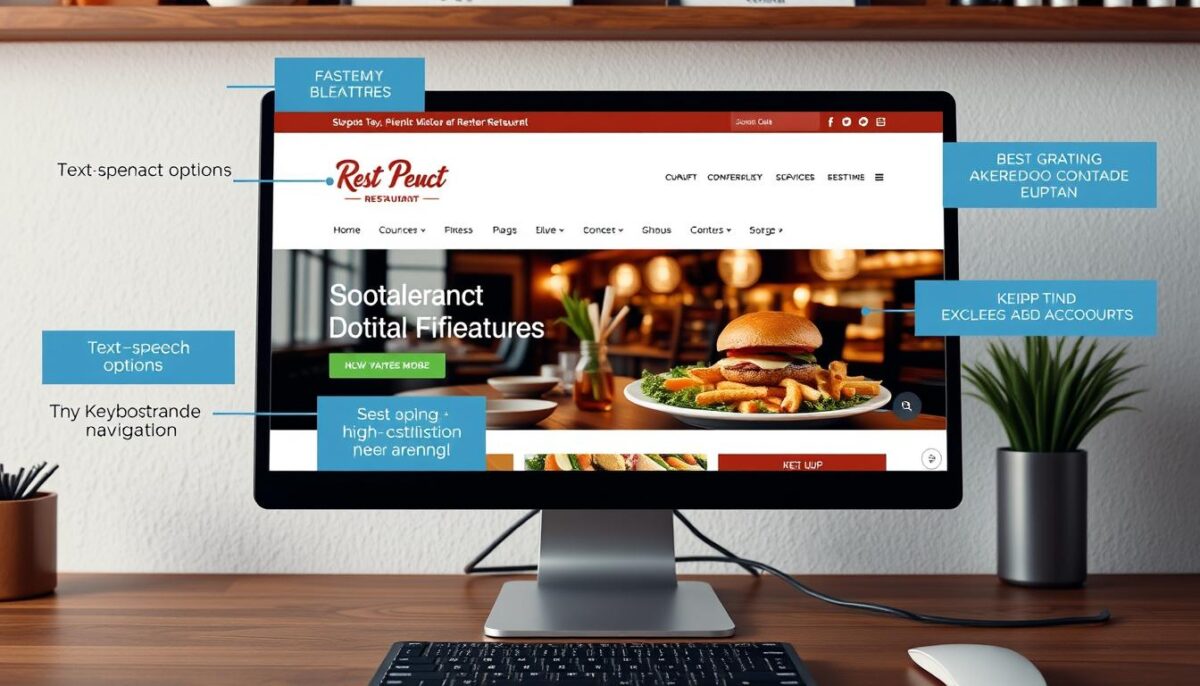
How to Pass Every Health Code Inspection on the First Try
July 27, 2025
6 Hidden Restaurant Marketing Tactics for Immediate Traffic Boost
July 28, 2025Imagine walking into your favorite restaurant only to find that it’s not accessible to you because of a disability. Unfortunately, this is a reality for many Americans, with approximately 61 million living with some form of disability.
This significant portion of potential customers is often overlooked, leading to not only a loss in customer base but also costly penalties and lawsuits for non-compliance with the Americans with Disabilities Act (ADA).
As a restaurant owner, ensuring accessibility is not just about avoiding legal issues; it’s about creating an inclusive dining experience for all customers. In this guide, we’ll explore common ADA violations in restaurants and provide practical solutions to avoid them, ensuring your establishment is welcoming to everyone.
Key Takeaways
- Understanding the critical importance of ADA compliance for restaurants.
- Recognizing common ADA mistakes that can lead to costly penalties.
- Learning practical solutions to ensure accessibility and inclusivity.
- Expanding your customer base by accommodating people with disabilities.
- Improving the overall dining experience for all customers.
Understanding the ADA and Why It Matters to Your Restaurant
As a restaurant owner, it’s crucial to understand the Americans with Disabilities Act (ADA) and its implications for your business. The ADA is a comprehensive civil rights law that prohibits discrimination against individuals with disabilities in all areas of public life. This law, enacted in 1990, is designed to provide equal access to goods and services for people with disabilities.
What Is the Americans with Disabilities Act?
The Americans with Disabilities Act (ADA) is a federal law that applies to various public and private entities, including restaurants and commercial kitchens. It is considered a successor to the Civil Rights Act of 1964, addressing the oversight of the disability community in the original legislation. The ADA is built on the principle of providing “equal access” to goods and services, which means removing barriers that might prevent someone from fully enjoying your restaurant.
How the ADA Specifically Applies to Restaurants
Restaurants fall under Title III of the ADA as “places of public accommodation” and must comply regardless of the size or age of the establishment. Compliance involves both physical spaces (entrances, seating, restrooms) and services (menus, websites, customer interactions). The core principle is to provide equal access to goods and services for people with disabilities. While some accommodations may require investment, many are considered “readily achievable” modifications that are reasonable for businesses to implement.
| ADA Compliance Areas | Description | Examples |
|---|---|---|
| Physical Spaces | Modifications to physical structures to ensure accessibility | Ramps, wide entrances, accessible restrooms |
| Services | Ensuring that services are accessible to all customers | Accessible menus, website accessibility, staff training |
By understanding and complying with the ADA, restaurants can create an inclusive environment where all customers feel welcome and valued. This not only helps in avoiding legal penalties but also enhances the overall dining experience for customers with disabilities.
The Legal Consequences of Non-Compliance
Non-compliance with ADA regulations exposes restaurants to substantial legal risks, including financial penalties and litigation. The Americans with Disabilities Act is enforced primarily through lawsuits, meaning that restaurants can face significant legal challenges if they fail to comply.
Potential Penalties and Fines
Restaurants that fail to comply with ADA regulations can face severe financial penalties. For instance, civil penalties can reach up to $75,000 for a first violation and $150,000 for subsequent violations. Beyond these government-imposed fines, restaurants may also be required to pay plaintiffs’ legal fees and damages, which can quickly add up to tens of thousands of dollars.
The financial burden of non-compliance can be substantial, making it crucial for restaurants to prioritize ADA compliance to avoid these costly penalties.
The Rising Trend of ADA Lawsuits Against Restaurants
ADA lawsuits against restaurants have increased dramatically in recent years. In 2021, approximately 11,400 people filed ADA lawsuits against “places of public accommodation,” many of which were small businesses. Many of these cases focus on specific issues such as website accessibility and parking lot compliance. Unlike other regulations, ADA compliance is primarily enforced through private lawsuits rather than regular government inspections, making it essential for restaurants to proactively ensure they are meeting ADA standards.
Some regions have become hotspots for ADA litigation, with certain law firms specializing in identifying non-compliant businesses. Settlements often include not just monetary compensation but also requirements to remediate all identified issues within specific timeframes, further emphasizing the need for proactive compliance.
Common Restaurant ADA Compliance Mistakes to Avoid
Despite good intentions, many restaurants fail to meet ADA standards, exposing them to potential legal consequences. Ensuring compliance with the Americans with Disabilities Act is not just about avoiding lawsuits; it’s about creating a welcoming environment for all customers. Food establishments are committed to serving all customers fairly, including offering reasonable accommodations for individuals with disabilities.
Overview of the Most Frequent Violations
Common types of disability-based claims and inquiries affect restaurant operators, often stemming from simple oversights rather than intentional non-compliance. Some of the most frequent ADA violations found in restaurants include:
- Issues with entrances, such as inadequate ramps or improper door hardware
- Interior pathways that are too narrow or obstructed
- Restrooms that lack proper accessibility features, such as grab bars or lowered sinks
- Digital accessibility problems, including inaccessible websites or online reservation systems
These violations can result from various factors, including poor layout design and insufficient staff training.
Why These Mistakes Happen
Many restaurant owners mistakenly believe that older buildings are “grandfathered in” and exempt from ADA requirements. However, the law requires removing barriers when “readily achievable.” Other common reasons for ADA non-compliance include:
- Gradually narrowing pathways or blocked access routes due to evolving restaurant layouts
- Gaps in staff training, particularly regarding service animal policies and customer interactions
- Budget constraints that lead owners to postpone accessibility improvements, not realizing that this approach often costs more in the long run through potential lawsuits
By understanding these common pitfalls, restaurant owners can take proactive steps to ensure ADA compliance and provide a more inclusive dining experience for all customers.
Entrance and Exterior Accessibility Issues
For many customers with disabilities, the entrance to your restaurant is their first barrier. Ensuring that this initial point of contact is accessible is not only a matter of compliance with the Americans with Disabilities Act (ADA) but also a crucial aspect of creating an inclusive dining experience.
Ramp Requirements
The ADA has strict guidelines for accessible entrances. If your entrance isn’t flush with the ground, you must provide a ramp that is at least 36 inches wide. The slope of the ramp should not exceed 2%. For ramps longer than 6 feet, handrails between 34 and 38 inches tall are required.

Door Width and Hardware
Accessible doorways must be at least 36 inches wide to accommodate wheelchairs. Door handles that require turning or squeezing, like typical knobs, are not considered accessible. Instead, consider using lever-style handles that are easier to operate for people with mobility impairments.
Signage Mistakes
Proper signage is crucial for directing customers to accessible entrances. The International Symbol of Accessibility should be displayed at entrances that are accessible. Conversely, entrances that are not accessible should have directional signage pointing to the nearest accessible entrance.
| Accessibility Feature | ADA Requirement |
|---|---|
| Ramp Width | Minimum 36 inches |
| Doorway Width | Minimum 36 inches |
| Handrail Height | Between 34 and 38 inches |
Parking Lot Compliance Errors
Compliance with ADA regulations in restaurant parking lots is vital for customer accessibility. If your restaurant has a parking lot, the ADA has specific guidelines to ensure that it is accessible to everyone. The general rule is that you need one designated “handicapped spot” for every 25 standard spaces.
Required Number of Accessible Spaces
The number of accessible parking spaces required is determined by the total number of parking spaces in your lot. For instance, if you have a parking lot with 100 spaces, you would need at least 4 accessible spaces. The ADA provides a chart to help determine the exact number based on your lot size.
| Total Parking Spaces | Minimum Accessible Spaces |
|---|---|
| 1-25 | 1 |
| 26-50 | 2 |
| 51-75 | 3 |
| 76-100 | 4 |
Van-Accessible Parking Requirements
At least one of your accessible parking spaces must be van-accessible. This means it needs to have an additional 3 feet of width and an 8-foot-wide access aisle to accommodate vans with lifts. The ADA requires that for every 6 accessible parking spaces, at least one should be van-accessible.
“The ADA requires that accessible parking spaces be located on the shortest accessible route to the entrance.”
Access Aisle and Route Mistakes
Common mistakes include failing to provide the required 5-foot-wide access aisles adjacent to accessible spaces or allowing these aisles to be blocked by carts, planters, or snow piles. The path from accessible parking to the entrance must be smooth, stable, and free from obstacles, with curb ramps where necessary.
By understanding and adhering to these guidelines, restaurants can avoid common parking lot compliance errors and ensure a more inclusive experience for their customers.
Interior Path of Travel Violations
The Americans with Disabilities Act (ADA) requires restaurants to have accessible interior routes that facilitate easy movement for all patrons. Ensuring that these paths are clear and wide enough is crucial for compliance.
Minimum Width Requirements
To be considered “accessible,” the interior path of travel must be at least 36 inches wide throughout the restaurant. This width allows for comfortable passage by wheelchair users. In high-traffic areas, even wider paths are recommended to accommodate more people. Restaurants often violate this requirement by adding more tables or decorative elements that narrow pathways below the minimum width.
Floor Surface Issues
The ADA states that floor surfaces must be “stable, firm, and slip-resistant.” Common violations include loose carpeting, highly polished floors that become slippery when wet, or uneven transitions between different flooring materials. It’s also crucial that threshold heights between different flooring surfaces do not exceed 1/2 inch (or 1/4 inch without beveling), as even small changes in level can create tripping hazards or barriers for wheelchair users.
Obstacles and Clearance Problems
Common obstacles that block accessible routes include movable furniture, promotional displays, waiting area seating, or self-service stations that encroach on the required clear width. Additionally, restaurants must provide adequate turning spaces, such as a 60-inch diameter circle or T-shaped space, in areas where a person might need to reverse direction, like dead-end corridors or alcoves.
By addressing these issues, restaurants can ensure that their interior paths of travel are compliant with ADA regulations, providing a more inclusive dining experience for all customers.
Dining Area and Seating Mistakes
Ensuring that your restaurant’s dining area is accessible to all customers is not just a matter of courtesy, it’s a legal requirement under the ADA. Many restaurants make critical mistakes in this area, potentially leading to legal consequences.
One of the primary concerns is the height and clearance of tables. According to ADA guidelines, an accessible table must have a surface height of no more than 34 inches and no less than 28 inches above the floor. Additionally, there must be at least 27 inches of knee clearance between the floor and the underside of the table. This ensures that customers using wheelchairs can comfortably dine.
Table Height and Clearance Requirements
To comply with ADA regulations, tables must not only meet the height requirements but also provide sufficient clearance for wheelchair users. This includes having a clear floor area of 30 inches by 48 inches at each seating location, with this area extending 19 inches under the table for leg clearance. Restaurants should be cautious of using tables with thick pedestals that could restrict knee clearance.
Distribution of Accessible Seating
It’s not enough to simply have accessible seating; it must be distributed throughout the dining area. At least 5% of your tables must be ADA compliant, but if you have fewer than 20 tables, you still need at least one accessible table. These tables should be dispersed among various types of seating, including booths, high-tops, and outdoor seating, to ensure that all customers have an equivalent dining experience.
| Seating Type | ADA Requirement | Common Mistake |
|---|---|---|
| General Seating | 5% of total tables | Not distributing accessible tables throughout the dining area |
| Booth Seating | Some tables with movable chairs | Not providing any booths with accessible seating |
| Outdoor Seating | Accessible tables included | Ignoring outdoor seating areas when assessing accessibility |
By understanding and addressing these common mistakes, restaurants can create a more inclusive dining environment that complies with ADA regulations, enhancing the experience for all customers.
Restroom Accessibility Failures
One of the most common areas for ADA violations in restaurants is restroom accessibility. Ensuring that your restrooms are accessible to customers with disabilities is not only a legal requirement but also a crucial aspect of providing an inclusive dining experience.
To comply with ADA regulations, your restaurant’s restrooms must be designed with accessibility in mind. This includes providing adequate space for wheelchairs, proper sink and fixture heights, and correctly installed grab bars.
Stall Size and Layout Issues
Accessible toilet stalls must meet specific size requirements. For wall-mounted toilets, the stall should be at least 60 inches wide and 59 inches deep. The door width should be a minimum of 32 inches, and the door should swing outward to avoid obstructing the required clear floor space.
A common mistake is failing to provide adequate turning space within the restroom. A circular diameter of 60 inches or a clear T-shaped area within a 60-by-60-inch square is required to permit three-point turns.
| Stall Dimension | Minimum Requirement |
|---|---|
| Width | 60 inches |
| Depth (wall-mounted) | 59 inches |
| Door Width | 32 inches |
Sink and Fixture Height Problems
Sink accessibility is another critical aspect of restroom design. The sink should be mounted at a height of no more than 34 inches to the rim, with a minimum knee clearance of 27 inches high, 30 inches wide, and 11-25 inches deep. This allows wheelchair users to pull up close enough to operate the faucet.
Key sink accessibility requirements:
- Maximum sink height: 34 inches
- Minimum knee clearance: 27 inches high, 30 inches wide, 11-25 inches deep
- Faucet should be usable with one hand, requiring no more than 5 pounds of force
- Exposed pipes under the sink should be insulated to prevent burns

Grab Bar Installation Mistakes
Proper grab bar installation is essential for supporting customers with disabilities. Horizontal grab bars are required on the rear wall (36 inches long) and side wall (42 inches long), mounted between 33-36 inches above the floor.
A common mistake is failing to install grab bars correctly or omitting them altogether. Ensuring that grab bars are securely installed and meet ADA specifications is crucial for providing safe and accessible restroom facilities.
By paying close attention to these details, you can create a more inclusive and accessible dining experience for all your customers.
Service Counter and Self-Service Area Compliance
Ensuring that your restaurant’s service counter and self-service areas are ADA compliant is crucial for providing an inclusive dining experience. This not only helps in avoiding legal penalties but also enhances customer satisfaction by making your establishment accessible to everyone.
Height and Reach Range Violations
To comply with ADA regulations, service counters where customers order or pay must have at least one accessible portion that is no higher than 36 inches from the floor and at least 36 inches wide. For counters where food is served, the accessible section should be at least 60 inches long and no more than 34 inches off the ground. It’s also important to consider the height of self-service counters; they should be no taller than 48 inches for a forward reach or 54 inches for a side reach. This ensures that all customers, including those with disabilities, can easily access condiments, tableware, and other items.
For instance, if your customers order food at the counter, make sure to have a section of counter at least 36 inches long that’s no more than 36 inches high, with a clear 30-by-48-inch floor space to accommodate a wheelchair user. Similarly, self-service counters housing condiments and tableware should be designed so that items are within accessible reach ranges. The best practice is to place self-service items towards the front of the counter, allowing patrons to grab them without assistance.
Clear Floor Space Errors
A clear floor space of at least 30 by 48 inches is required in front of service counters and self-service areas to allow wheelchair users to approach and use these features comfortably. This means that the area should be free from obstacles such as chairs, tables, or other furniture that could hinder access. Ensuring adequate aisle width, particularly in buffet and self-service lines, is also crucial. A minimum aisle width of 36 inches is recommended to facilitate easy navigation for customers with mobility impairments.
Common violations in self-service areas include placing condiments, utensils, or drink dispensers too high or too far back on counters, making them inaccessible to people with limited reach. To avoid such issues, restaurants should design their buffet and self-service lines carefully, ensuring that food items are visible and reachable from a seated position. By doing so, restaurants can create a more inclusive environment that caters to the needs of all customers.
Service Animal Accommodation Mistakes
Service animals play a vital role in assisting customers with disabilities, and restaurants must accommodate them. As a restaurant owner, understanding the rules surrounding service animals is crucial to avoid ADA penalties and create an inclusive dining experience for all customers.

Understanding What Questions You Can Legally Ask
When a customer arrives with a service animal, it’s essential to know what questions you can legally ask. According to the ADA, you can ask two specific questions: (1) Is this a service animal required because of a disability? and (2) What work or task has the animal been trained to perform? It’s crucial not to ask for proof of disability, identification, or certification for the animal, as this is not required by law.
Many restaurant staff mistakenly believe they can ask for certification or demonstration of the animal’s abilities. However, the ADA strictly limits the inquiries you can make. By understanding these boundaries, you can ensure you’re respecting your customers’ privacy while also verifying the legitimacy of their service animal.
- Only ask if the animal is a service animal required because of a disability.
- Inquire about the work or task the animal has been trained to perform.
- Avoid asking for proof of disability or certification.
Common Misconceptions About Service Animals
There are several misconceptions about service animals that can lead to mistakes in accommodation. One common misunderstanding is the difference between service animals and emotional support animals. Service animals are dogs or miniature horses trained to perform specific tasks for individuals with disabilities and are protected under the ADA. Emotional support animals, on the other hand, are not covered by the ADA in public accommodations.
Another misconception is that service animals can behave freely in a restaurant. While service animals are allowed in dining areas, they must be under control, housebroken, and not disruptive to other customers. If a service animal is barking, growling, or causing a disturbance, you can ask the owner to remove the animal. However, it’s essential to remember that the customer must still be welcomed to stay and receive service.
By understanding the rules and common misconceptions about service animals, restaurants can better accommodate their customers with disabilities, creating a more inclusive and welcoming environment. This not only helps avoid ADA penalties but also enhances the overall dining experience for all customers.
Digital Accessibility Oversights

Your restaurant’s website is more than just a digital brochure; it’s a place of public accommodation that must comply with ADA standards. Ensuring your website is accessible to everyone, including those with disabilities, is crucial for avoiding legal issues and providing an inclusive experience for all customers.
Website Accessibility Requirements
The Web Content Accessibility Guidelines (WCAG) provide a framework for making your website perceivable, operable, understandable, and robust. This means incorporating features like alt image descriptions, text transcripts for audio and video content, and ensuring keyboard navigability. Your website should also have consistent color contrast and should not rely solely on color to convey important information.
Some common mistakes include not providing alt text for images, failing to caption videos, and having forms that can’t be navigated using a keyboard. Ensuring your website meets these standards is key to digital accessibility.
Online Menu and Reservation System Issues
Online menus and reservation systems are critical components of your restaurant’s website. Menus must be accessible to screen readers, which means avoiding PDF formats unless they are properly tagged. HTML-based menus are generally a safer choice. Reservation systems should also be accessible, with date pickers and forms that can be navigated using a keyboard and CAPTCHA challenges that have audio alternatives.
It’s also important to avoid relying on accessibility overlay widgets as a quick fix. While they might seem like an easy solution, these tools often create more problems than they solve and don’t provide comprehensive compliance. Ensuring your website is inherently accessible is the best approach.
Steps to Audit Your Restaurant for ADA Compliance
To avoid costly penalties and enhance customer satisfaction, auditing your restaurant’s ADA compliance is a must. Ensuring that your establishment meets the Americans with Disabilities Act standards not only protects your business from legal issues but also fosters an inclusive environment for all patrons.
DIY Compliance Checklist
Begin by conducting a thorough walk-through of your restaurant, starting from the exterior. Check the parking lot for the required number of accessible spaces and ensure that the access aisle is clear and wide enough. Move inside and examine the entrance, doorway widths, and the path of travel throughout the dining area. Make sure that your restrooms are equipped with grab bars, lowered sinks, and adequate space for maneuverability.
Use a practical DIY checklist to cover key measurements and features, such as counter heights, table clearances, and signage requirements. Document compliance issues with photos and notes, creating a prioritized remediation plan based on the complexity and cost of needed modifications.
When to Hire a Professional ADA Consultant
While a DIY audit is a good starting point, there are situations where hiring a professional ADA consultant makes sense. If you’re planning major renovations, have received a complaint, or are dealing with a historic building that has special considerations, expert advice can be invaluable. Look for a consultant with credentials in accessibility consulting and experience with food service establishments.
A qualified ADA consultant will provide practical, cost-effective solutions tailored to your restaurant’s specific needs, ensuring that you’re not only compliant but also providing the best possible experience for your customers.
Conclusion: Creating an Inclusive Dining Experience While Avoiding Penalties
Ensuring your restaurant is ADA compliant isn’t just about avoiding penalties; it’s about crafting a welcoming environment for all customers. Throughout this article, we’ve explored key areas of ADA compliance, from entrance and exterior accessibility to digital accessibility oversights.
By addressing these common mistakes, restaurants can enhance their overall customer experience, making their business more inclusive for people with disabilities. Many accessibility improvements benefit all customers, not just those with disabilities, by creating more comfortable, navigable spaces.
Remember, ADA compliance is an ongoing process that requires regular attention, especially as your business ages or undergoes renovations. A proactive approach to accessibility is more cost-effective than waiting for complaints or legal action.
Start your accessibility journey today by auditing your restaurant using the simple steps outlined in the previous section. By doing so, you’ll not only avoid costly penalties but also create a more inclusive and welcoming environment for all customers, ultimately benefiting your business.
FAQ
What are the most common ADA mistakes made by restaurants?
Restaurants often fail to provide accessible parking, have inadequate entrance ramps, and insufficient accessible seating. Ensuring that your parking lot has the required number of accessible spaces and that the entrance is wide enough and has a proper ramp can help avoid these issues.
How many accessible parking spaces are required?
The number of accessible parking spaces required depends on the total number of parking spaces in your lot. For example, if you have 100 parking spaces, you need at least 4 accessible spaces, with one being van-accessible.
What is considered an accessible route?
An accessible route is a continuous path that connects the accessible entrance to the accessible seating and other facilities. It should be at least 36 inches wide and free of obstacles, allowing individuals with disabilities to navigate easily.
How high should tables be to be considered accessible?
Tables should have a clear floor space of at least 30 inches by 48 inches and a surface height of no more than 34 inches above the floor to be considered accessible. This allows individuals with mobility impairments to comfortably sit and dine.
Can I ask customers if they have a disability?
No, you cannot ask customers if they have a disability. However, you can ask if they need assistance or accommodations. When it comes to service animals, you are allowed to ask limited questions to determine if the animal is a legitimate service animal.
What are the requirements for website accessibility?
Your website should be designed to be accessible to individuals with disabilities, including those with visual, auditory, or cognitive disabilities. This includes having clear navigation, alt text for images, and ensuring that your online menu and reservation system can be used with assistive technologies.
How can I ensure my restaurant is ADA compliant?
Conducting a thorough audit of your restaurant, including the parking lot, entrance, dining area, restrooms, and website, can help identify areas that need improvement. You can use a DIY compliance checklist or hire a professional ADA consultant to ensure you are meeting the necessary standards.
What are the consequences of not being ADA compliant?
Failure to comply with the ADA can result in significant penalties and fines, as well as costly lawsuits. Ensuring that your restaurant is accessible to individuals with disabilities can help avoid these issues and create a more inclusive dining experience.



